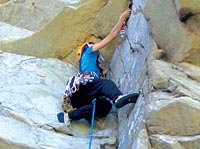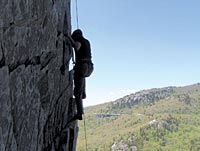Since crossing the finish line of my first 10K road race when I was 5 years old, I’ve only taken a few breaks from running. As a running coach, I’m always encouraging runners to cross-train to give their bodies and mind a break from pounding the pavement (or the trail), and I try to follow the same advice.

So in that spirit, I recently made a point to get together with some friends for a day of climbing. The last time I did so was some years back. That time, I distinctly remember stalling midclimb to searching for my next hold. I felt around the jagged granite until they dived into what my I assumed was a misplaced bird’s nest. While my fingers raked through this leafy brush, a buzzing mass engulfed my hand and traced down my arm and into my hair. A second later, the stings began. My belayer (the guy holding me up on the ropes), was out of sight at the top of the rock face, but could hear screams of “Bees! Lower me now!” He let me down as fast as he could.
A few weeks ago my friend Michelle Reames told me about her plans to climb with some friends at Ship Rock, a well-known spot near Grandfather Mountain. She invited me along, and I said yes, trying to hold memories of the stings at bay.
After a two-hour drive, we loaded more than a hundred pounds of gear (ropes, helmets, cams, harnesses, shoes etc.) into our packs and began our march up the mountainside. The half-hour rock-hop was so steep that, in places, Michelle was forced to carry her German Shepherd, Kootenay. Above and around us, a backdrop of blue sky contrasted with greening mountain peaks. It was a scene to behold, and promised to be even better at the top.
But first, gear had to be unloaded and checked over for defects or missing pieces, ropes flaked (untangled and arranged in neat coils), and routes tediously planned out. Before the group could begin climbing, a top rope had to be set out. This involves attaching a rope to two anchors located at the top of the route. Skilled “lead-climbers” must self-belay themselves to the top in order to do this, a painstaking process. And although lead climbers pull rope up with them and clip themselves in along the way, they expose themselves to a considerable risk of fall, if only over a short distance.

Rock climbing is an unhurried process. In fact, our group’s energy reminded me of a video I once saw of a NASA team suspended in the shuttle, hard at work. Adventure is coupled with risk for lead climbers, who must place cams and repeatedly test their strength. They take all the time they need to plan their next move. Some moves might require 10 minutes of strategic thinking; the result is a preternatural show of agility and strength as the climber appears to ascend mirror-finish sections of rock with eerie flicks.
As a top-roper and beginning climber I had yet to develop the apelike prowess or gravity-defying moves these lead climbers seemed to posses, but I moved up the rock face with unexpected ease. Still, on “Hindu Kush,” one of the toughest climbs I tried, the fear of falling kept me digging my nails into the rock all the way to the top. “Hindu” is rated a 5.8 on the Yosemite decimal system, which translates into a fairly difficult climb where hand- holds are at times nonexistent, forcing climbers to pinch tiny nubs of rock and “smear” their tight rubber bottom shoes against the concave surfaces below them in order to seek out easier sections of the route. Using chalk on your hands helps, but my more experienced friends told me that the key is using the legs efficiently, so that the hands serve as a support rather than the propelling force.
For me, the real journey began when I made it to the top. I asked if I could just climb back down. “No,” was the answer. They told me I had to lean back, push my feet flat against the rock, and walk down. Not only did I have to conjure some hidden reserve of pure nerve to lean back in midair with nothing below me but hungry stone, but I needed to do it while trusting that the two bolts holding the top rope in place wouldn’t pop out.
Half-way down, I was still conscious enough to see my rope catch between a sharp natural “V” formed in the rock. In my mind, the rope was still smoking and tearing into slivers as it scraped over that sharp spot, but just before my determination failed me, I was once again earthbound—home sweet home.


Before you comment
The comments section is here to provide a platform for civil dialogue on the issues we face together as a local community. Xpress is committed to offering this platform for all voices, but when the tone of the discussion gets nasty or strays off topic, we believe many people choose not to participate. Xpress editors are determined to moderate comments to ensure a constructive interchange is maintained. All comments judged not to be in keeping with the spirit of civil discourse will be removed and repeat violators will be banned. See here for our terms of service. Thank you for being part of this effort to promote respectful discussion.